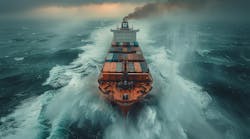Following the largest earthquake to strike Hawaii in 23 years, state officials diverted barge traffic from Kawaihae Harbor to Hilo. Matson (www.matson.com) reported its barge Mauna Loa was diverted and drayage was delayed by road damage, but impact was minimal to its operations.
Horizon Lines (www.horizon-lines.com) also reported only minimal disruption and, after inspection, said all of its cranes at the Port of Honolulu were fully operational.
The U.S. Coast Guard closed the harbor temporarily to examine ruptured water lines and cracks that ran nearly the length of one of two piers at the harbor. Local media reported Senator Daniel Akaka said, "It was terrible to see the piers were disconnected from the land and then put back again. It will require some extensive work there. We looked at it with the idea of repairing it, but we may have to rebuild it.” He was joined by Senator Daniel Inouye in calling for federal funds to help repair damage to the roads and bridges.
Kawaihae Harbor is located on the northwest coast of the Island of Hawaii and is one of two deep-draft ports serving the island. Water depth is 40 feet in the entrance channel and 35 feet in the harbor basin. There were no reports following the earthquake to indicate if there was any change to the channel draft or harbor basin.
An earlier report by the state’s Hawaii Commercial Harbors 2020 Master Plan task force stated, “The importance of cargo shipping to our State cannot be overstated.” Acknowledging the importance of passenger, sport and leisure use of the harbor, the task force then noted, “Commercial harbor planning must first address Hawaii’s life-sustaining cargo operations.” Overseas container volume was estimated to reach 110,300 twenty-foot-equivalent units (TEUs) by 2020, four times the 25,711 recorded in 1986.
Much of the volume of containers goes through the main island harbors and moves to adjacent islands by barge. The task force acknowledged that while the number of calls at each harbor was increasing, the number of berths remained static.


